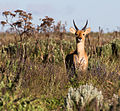This article relies largely or entirely on a single source .(October 2023) |
| Reedbucks | |
|---|---|
 | |
| Bohor reedbuck | |
| Scientific classification | |
| Kingdom: | Animalia |
| Phylum: | Chordata |
| Class: | Mammalia |
| Order: | Artiodactyla |
| Family: | Bovidae |
| Subfamily: | Reduncinae |
| Genus: | Redunca Hamilton Smith, 1827 |
| Type species | |
| Antilope redunca Pallas, 1767 | |
| Species | |
| |
Reedbuck is a common name for African antelopes from the genus Redunca. [1]
Bohor reedbucks belong to the family Bovidae and subfamily Reduncinae. Bohor reedbucks are known to be savannah grazers that live near water sources. They have been found in areas like the Bale Mountains National Park in Ethiopia. [2] Southern reedbucks are found near elevated land, including places in South Africa like Natal. [3]
The reedbuck is distinguished by a round glandular spot below each ear, with males having forward-curving horns that vary in size and shape among species. There are three recognised species of reedbuck: the southern reedbuck is the largest, while the mountain reedbuck is the smallest.


